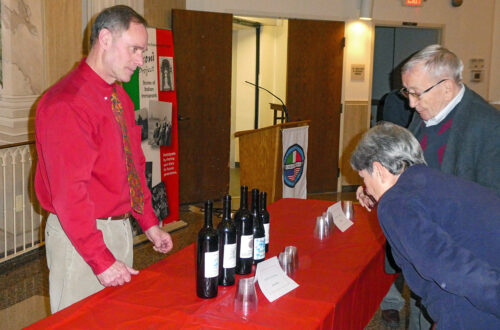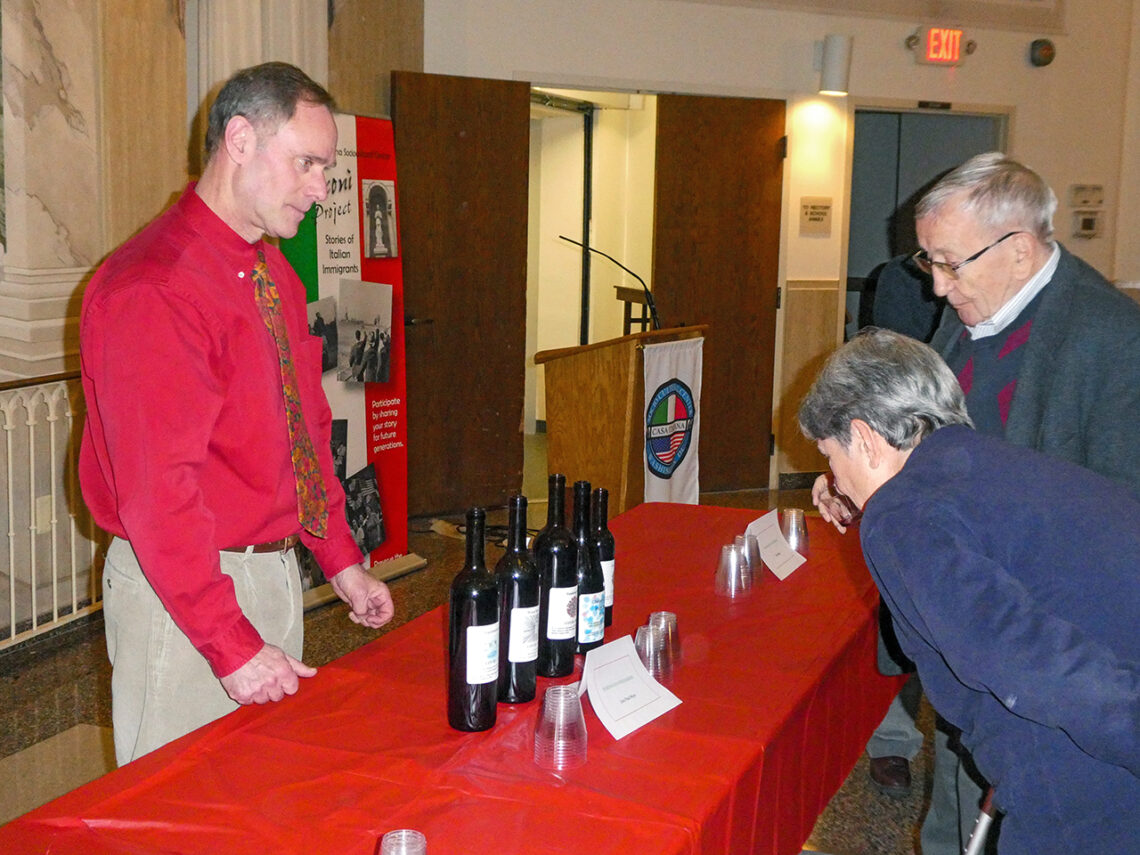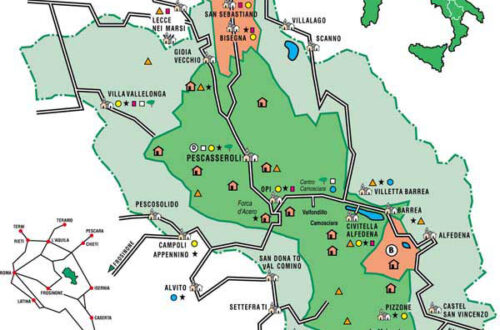-
Former AMHS President Dick DiBuono Assisted in Venice Flood Barrier Project
By Nancy DeSanti

AMHS Past President Dick DiBuono. Credit: AMHS archive photo The flood barrier system in Venice had its first real “stress test” on November 22, 2022, when all 78 of the MOSE dams were raised to save the Italian city from flooding. But this successful project was developed over a period of years, and with the assistance of former AMHS President Dick DiBuono and the U.S. Army Corps of Engineers.
With sea waters reaching more than 1.7 meters above the normal level, an estimated 82 percent of the canal city’s footpaths would have been under water without the protective floodgates.
It was the third-highest water level since records began in 1923, according to Italian news reports, after the devastating “acque alte” of November 4, 1966 (1.94 meters) and November 12, 2019 (1.87 meters). First planned in 1984, the multi-billion-euro MOSE project was operated for the first time in October 2020. It is designed to protect Venice from tides of up to three meters.
The project’s official title is Modulo Sperimentale Elettromeccanico (MOSE) but it also carries a reference to the biblical prophet Moses who parted the waters of the Red Sea.
Dick DiBuono noted that back in the 1990s, a group of engineers from Italy, who were working on the planning and design of these barriers in Venice, came to Washington to visit with him and some of his colleagues at the headquarters of the Army Corps of Engineers where he was senior hydraulic engineer and water control manager.
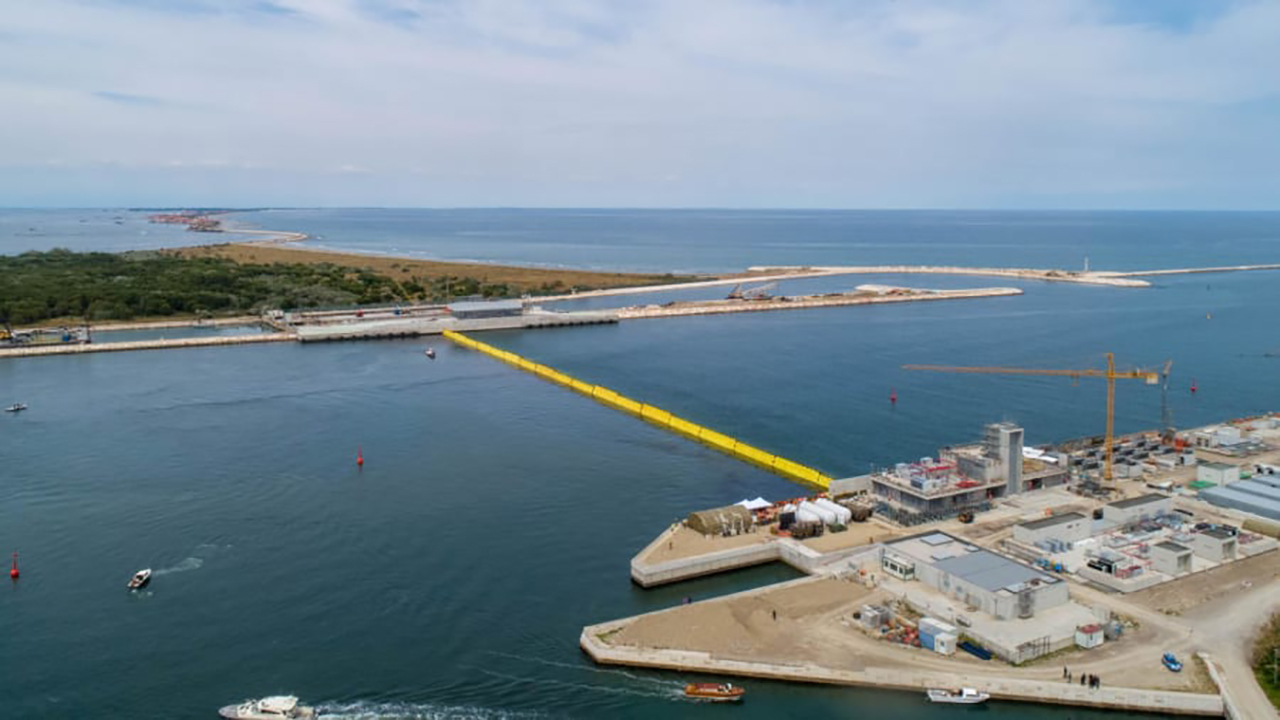
The Venice flood barrier.
Credit: cnn.com / Consorzio Venezia NuovaHe explained that they did so because of his agency’s experience with the design, construction and operation of several hurricane barriers along the coastline of the New England states of Massachusetts, Rhode Island and Connecticut. He noted that the Italian engineers particularly liked the method chosen for the Stamford, Connecticut, barrier and used that concept in their design.
Dick commented: “Roads, aqueducts, ports, harbors, fortifications — our Roman ancestors were the forefathers of today’s civil engineering profession. They were builders, not destroyers, and their genes, apparently having been passed down the generations, must be why I chose to be one.”
He added that in listing the major Roman roads on the Italian peninsula, the list should include Via Flaminia, the major road/route north out of Rome to the Adriatic Sea where it terminates in the center of the city of Fano, where some of his relatives live. Its construction was ordered by Caesar Augustus, he noted, and this road is still in use today. It passes by Spoleto on its way to Fano. Dick said he has driven it two or three times, adding that one Roman-built bridge is still used on that road.
January/February 2023
-
AMHS Winetasting Event Held in November
By Nancy DeSanti, 1st Vice President-Programs
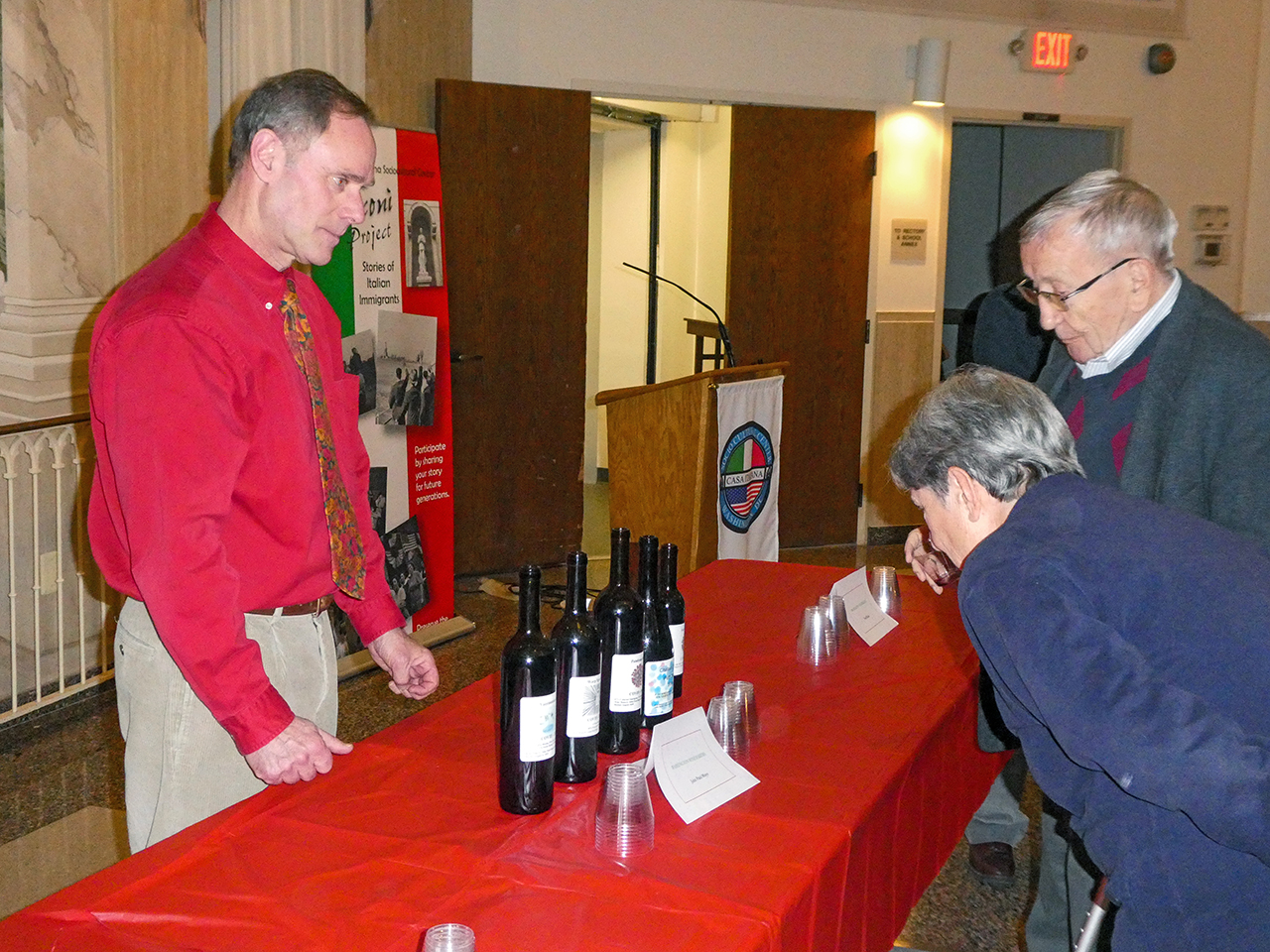
Washington Winemaker John Paul Maye (left) presented his work to guests at the November 29 general meeting, including AMHS President Emeritus Lucio D’Andrea (right).
Credit: Sam YothersApproximately 60 AMHS members and guests came to Casa Italiana on November 20, 2022, to sample the craft of Washington Winemaker John Paul Maye. Attendees also enjoyed a delicious lunch catered by the always popular Three Brothers Restaurant.
The November meeting featured a short business session at which AMHS members formally elected three new members of the Board of Directors. Assuming office in January will be Julie Finigan Dal Forno, John Iazzetti and Teresa Margaret Talierco. We thank the outgoing board members, John Dunkle, Chris Renneker and Joseph “Sonny” Scafetta, Jr., for their service during the past three years.
AMHS President Ray LaVerghetta thanked his predecessor, Maria D’Andrea-Yothers, for her tireless service over many years to the Society of which her parents, Lucio and Edvige D’Andrea, were founding members. Maria stepped down from her current responsibilities as of the end of 2022, but she will remain an active member as she looks forward to her retirement in 2024 and a subsequent move away from the area. AMHS Vice Presidents Nancy DeSanti and Lynn Sorbara added their thanks and appreciation.
Our thanks go to Jim Gearing of Washington Winemakers, and all those who organized the lunch, including Lynn Sorbara, Frank Bonsiero, and Mark Lino. And a big thanks to all those who bought donated raffle prizes and bought tickets for the raffle.
January/February 2023
-
Bisenti

By Nancy DeSanti
Province of Teramo, Region of Abruzzo
The small medieval town of Bisenti, located in the province of Teramo, has approximately 2,061 inhabitants.
The old part of Bisenti is still preserved in the streets and squares of the historic center. The Piazza Vittorio Emanuele overlooks the parish church of Santa Maria degli Angeli, which houses a majestic bell tower. According to tradition, the church is related to the Franciscan order. It was once considered one of the major basilicas of Abruzzo during the 15th and16th centuries.
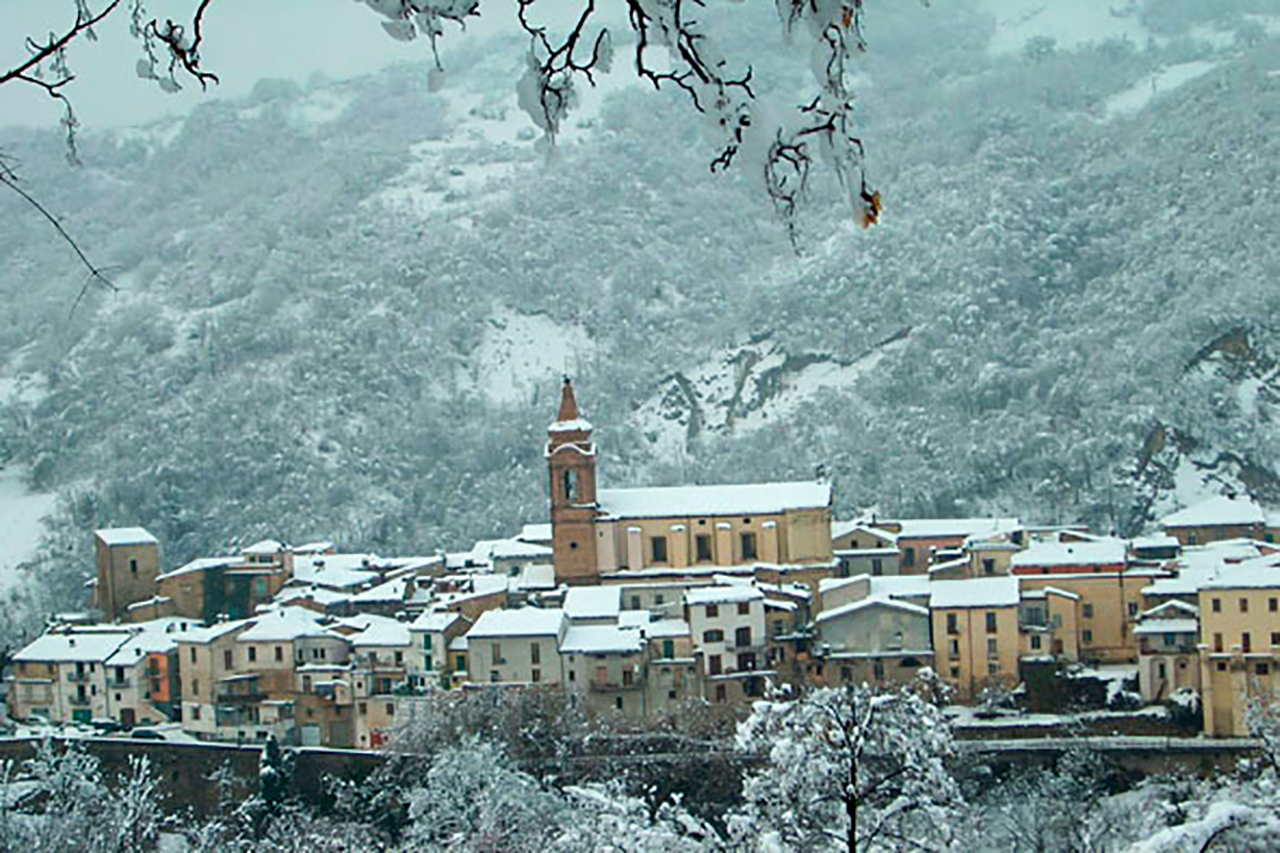
The town of Bisenti in winter.
Credit: WikipediaThere is an old tradition linking the birthplace of Pontius Pilate, who had Jesus Christ crucified, to the village of Bisenti. There are ruins of a Roman house known as “The House of Pilate.” Many locations, most of them in modern Abruzzo, lay claim to being the birthplace of Pontius Pilate based on local legends. There are no clear historic records of Pilate before his nomination to the post of the governor of the Roman province of Judea.
However, the book “Io, Ponzio Pilato di Bisenti,” written by local authors Angelo Panzone and Graziano Paolone, argues that Bisenti is Pilate’s most likely birthplace. For tangible proof of his presence in Bisenti, they say the water system and the building that locals call “Pontius Pilate’s House” has an underground aqueduct common in Middle Eastern countries. And in Bisenti, the authors say one finds an aqueduct similar to the hydro system in Jerusalem, which was supposedly built by Pilate with temple money during his time as governor in Judea.
Human settlements of the Iron Age in the 8th century B.C. attest to the ancient origin of the center. The present village rose in the 12th century and belonged to the Anjou family, the Montecassino Monastery, and lastly the Acquaviva family.
What to See
- The Castello, with two U-shaped towers from the 12th century
- The Casa Abbaziale of the 15th century, restored in the 18th century
- Church of Santa Maria degli Angeli, with its high belltower, of medieval origin but rebuilt in the early 18th century by Neapolitan Francesco de Sio, with a beautiful earthenware statue of the Madonna with Child probably by Gian Francesco Gagliardelli
Important Dates
- May 17 — Feast of St. Pascal Baylon, the patron saint
- July — Sagra dell’Emigrante, Sagra della gastronomia Bizantina
- August 2 — Celebration in honor of Madonna degli Angeli, with a procession of women in traditional costumes
- First Sunday in October — Sagra Uva e Vino montonico, with a procession of allegorical carts and the singing of wine harvest songs.
Italiano

Tradotto da Ennio Di Tullio
Provincia di Teramo, Regione Abruzzo
Il piccolo comune di Bisenti, trova in provincia di Teramo, conta circa 2,061 abitanti.
La parte antica di Bisenti è ancora conservata nelle vie e nelle piazze del centro storico. Sulla Piazza Vittorio Emanuele si affaccia la chiesa parrocchiale di Santa Maria degli Angeli, che custodisce un maestoso campanile. Secondo la tradizione la chiesa è imparentata con l’ordine francescano. Un tempo era considerata una delle basiliche maggiori d’Abruzzo nei secoli XV e XVI.
Esiste un’antica tradizione che lega il paese natale di Ponzio Pilato, che fece crocifiggere Gesù Cristo, era al paese di Bisenti. Ci sono rovine di una casa romana conosciuta come “La casa di Pilato.” Molte località, la maggior parte delle quali nell’Abruzzo moderno, rivendicano di essere il luogo di nascita di Ponzio Pilato sulla base di leggende locali. Non ci sono chiari documenti storici di Pilato prima della sua nomina alla carica di governatore della provincia romana della Giudea.
Tuttavia, il libro “Io, Ponzio Pilato di Bisenti,” scritto dagli autori locali, Angelo Panzone e Graziano Paolone, sostiene che Bisenti sia il luogo di nascita più probabile di Pilato. A testimonianza tangibile della sua presenza a Bisenti, si dice che il sistema idrico e l’edificio che i locali chiamano “Casa di Ponzio Pilato” abbia un acquedotto sotterraneo comune nei paesi mediorientali. E a Bisenti, dicono gli autori, si trova un acquedotto simile al sistema idrico di Gerusalemme, che sarebbe stato costruito da Pilato con i soldi del tempio durante il suo periodo come governatore in Giudea.
Insediamenti umani dell’età del ferro nell’VIII secolo A.C. attestano l’antica origine del centro. L’attuale borgo sorse nel XII secolo e appartenne agli Angioini, al Monastero di Monte Cassino, e infine agli Acquaviva famiglia.
Le attrazioni del luogo:
- Il Castello, con due torri a forma di U del XII secolo
- La Casa Abbaziale del XV secolo, restaurata nel XVIII secolo
- Chiesa di Santa Maria degli Angeli, con il suo alto campanile, di origine medioevale ma rifatta agli inizi del ‘700 dal napoletano Francesco de Sio, con una bella statua in terracotta della Madonna col Bambino probabilmente di Gian Francesco Gagliardelli
Date da ricordare:
- 17 maggio — festa di San Pascal Baylon, patrono
- Luglio — Sagra dell’Emigrante, Sagra della gastronomia Bizantina
- 2 agosto — Festa in onore della Madonna degli Angeli, con processione di donne in costumi tradizionali
- Prima Domenica di ottobre — Sagra Uva e Vino montonico, con sfilata di carri allegorici ed il canto dei canti della vendemmia.
Sources: https://en.wikipedia.org/wiki/Bisenti
https://www.italyheritage.com/regions/abruzzo/teramo/bisenti.htm
https://www.abruzzissimo.com/2020/10/12/pontius-pilate-from-bisenti-in-abruzzo
January/February 2023
-
Scapoli

By Nancy DeSanti
Province of Isernia, Region of Molise
The town of Scapoli is located in the western area of the province of Isernia in Molise, near the region of Lazio. It has approximately 758 inhabitants.
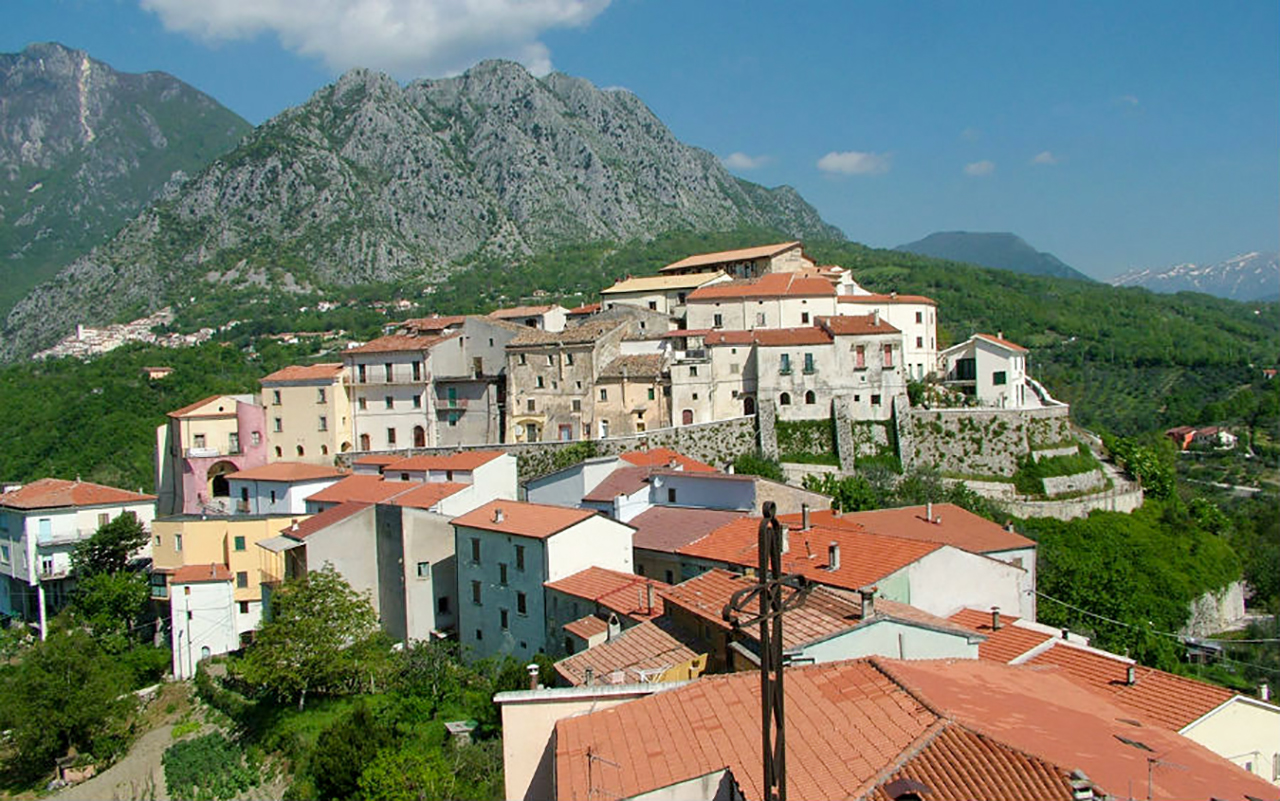
A panoramic view of Scapoli.
Credit: e-borghi.comThe fame of Scapoli rests on a bagpipe known as a zampogna, an instrument invented by the Samnites and then used by the Romans to frighten the horses of the enemy. There are still workshops making this ancient instrument which, being the musical instrument of shepherds, was then connected to Christmas.
The town is notable for its bagpipes museum and for the international bagpipe festival which, each year in the month of July, attracts pipers from around the world to come and perform in Scapoli.
Two types of zampogna are made in Scapoli — “con chiave” (or “keyed” pipes) and “la zoppa” (or “lame” pipes). Historians say Emperor Nero especially loved to play an instrument known as “utriculus,” which was made with pipes inserted in a goat skin. Today, Scapoli is the only area in Italy that still has a solid and skilled production of zampognas, and the master craftsmen continue the Molise bagpipe-making tradition, jealously guarding the secrets of their ancient techniques.
Zampogna making follows established methods and techniques handed down over the centuries to younger generations by master craftsmen. After the selection and natural seasoning of olive and cherry wood, the various pieces that will make up the instrument are shaped on a lathe and with simple carpentry tools.
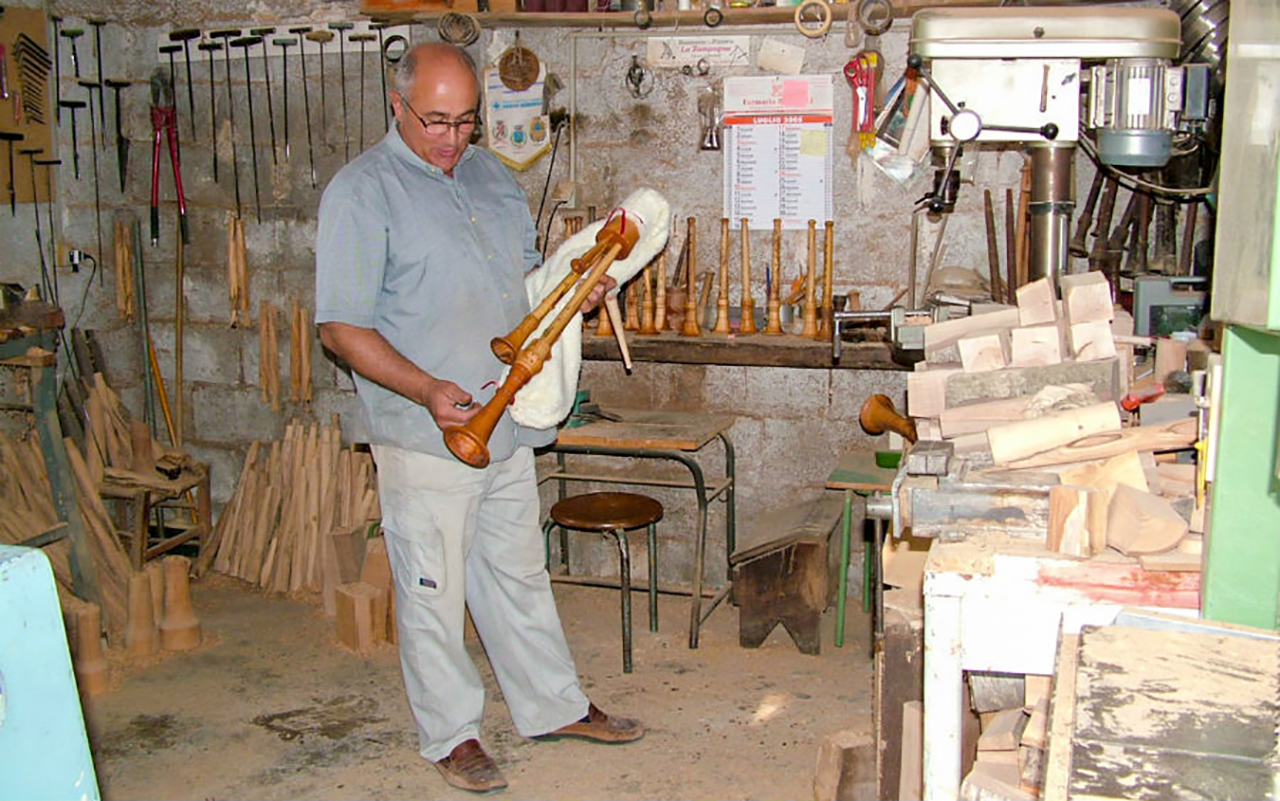
A Scapoli craftsman with a zampogna.
Credit: e-borghi.comThe small town rose on the sides of the Mainarde, on an elevated terrain relic of a prehistorical glacier. After the first destruction by the Saracens of the Abbey of San Vincenzo al Volturno in the 9th century, the surviving monks gathered the population away from the abbey and organized them in small farms called “curtes”, thus creating a network of fortified boroughs, among which was Scapoli.
Though always under the influence of the Abbey of San Vincenzo, Scapoli was ruled by a number of feudal lords, among them the Borrello, who ruled over the whole Volturno Valley until 1050 AD. Later, the fiefdom passed to the Caldora, the Pandone, then in the 15th century to the Bucciarelli family, until in 1626, when it was auctioned and given to Baron Innico di Grazia from Cerro al Volturno.
What to See
- The Church of San Giorgio, from the 17th century, recently restored
- The Lombard Fortress also known as Scarupato, which is a kind of pathway embracing the whole historical center.
- The Church of Santa Maria delle Grotte, on the road to Rocchetta a Volturno, immersed in an impressive natural landscape and having magnificent frescoes.
Important Dates
- April 23 — Feast of San Giorgio, the patron saint
- Last week in July — Festival Internazionale della Zampogna (bagpipe festival), with performances of zampogna and ciaramelle (bagpipes), still built as 2,000 years ago.
Italiano

Tradotto da Ennio Di Tullio
Provincia di Isernia , Regione Molise
Comune di Scapoli è situato nella zona occidentale della provincia di Isernia in Molise, a ridosso della regione Lazio. Ha circa 758 abitanti.
La fama di Scapoli si fonda su una cornamusa detta zampogna, strumento inventato dai Sanniti e poi utilizzato dai Romani per spaventare i cavalli del nemico. Ancora oggi esistono laboratori di lavorazione di questo antico strumento, che, essendo lo strumento musicale dei pastori, era poi legato al periodo natalizio.
La città è nota per il suo museo della zampogna e per il festival internazionale della zampogna che, ogni anno nel mese di luglio, richiama suonatori di cornamusa da tutto il mondo per esibirsi a Scapoli.
A Scapoli si producono due tipi di zampogna: “con chiave” (o pipe “a chiave”) e “la zoppa” (o pipe “zoppe”). Gli storici dicono che l’imperatore Nero amava particolarmente suonare uno strumento noto come “utriculus”, che era realizzato con tubi inseriti in una pelle di capra. Oggi Scapoli è l’unica zona in Italia che conserva ancora una solida e qualificata produzione di zampogne, e i maestri artigiani continuano la tradizione molisana della zampogna, custodendo gelosamente i segreti delle loro antiche tecniche.
La lavorazione della zampogna segue metodi e tecniche consolidate tramandate nei secoli alle giovani generazioni dai maestri artigiani. Dopo la selezione e stagionatura naturale del legno di ulivo e ciliegio, vengono modellati al tornio e con semplici attrezzi da falegnameria i vari pezzi che andranno a comporre lo strumento.
Il piccolo centro sorse sulle sponde delle Mainarde, su un terreno elevato relitto di un ghiacciaio preistorico. Dopo la prima distruzione da parte dei Saraceni dell’Abbazia di San Vincenzo al Volturno nel IX secolo, i monaci superstiti raccolsero la popolazione lontano da l’abbazia e li organizzò in piccole masserie chiamate “curtes”, così creando una rete di borghi fortificati, tra cui era Scapoli.
Pur essendo sempre sotto l’influenza dell’Abbazia di San Vincenzo, Scapoli fu governata da numerosi feudatari, tra cui i Borrello, che dominarono l’intera Valle del Volturno fino al 1050 dC. Successivamente il feudo passò ai Caldora, ai Pandone, poi nel XV secolo al Bucciarelli famiglia, fino al 1626, quando fu messo all’asta e ceduto al barone Innico di Grazia di Cerro al Volturno.
Le attrazioni del luogo:
- La Chiesa di San Giorgio, del XVII secolo, recentemente restaurata
- La Rocca Longobarda detta anche dello Scarupato, che è una sorta di viale che abbraccia tutto il centro storico
- La Chiesa di Santa Maria delle Grotte, sulla strada per Rocchetta a Volturno, immersa in un suggestivo paesaggio naturale e con magnifici affreschi.
Date da ricordare:
- 23 aprile — Festa di San Giorgio, patrono
- Ultima settimana di luglio — Festival Internazionale della Zampogna, con esibizione di zampogna e ciaramelle, costruite ancora come 2,000 anni fa
January/February 2023
-
Clarification on Angela Lastrico Raish Scholarship
In the November/December issue of the Notiziario, we reported that the AMHS would administer the Angela Lastrico Raish Scholarship which is separate from and in addition to the two scholarship awards given by the Society each academic year. The source of the funding for the Raish scholarship was incorrectly stated. In fact, the funds for the Angela Lastrico Raish Scholarship are, and will be, from private donations. The Notiziario regrets the error.
January/February 2023

